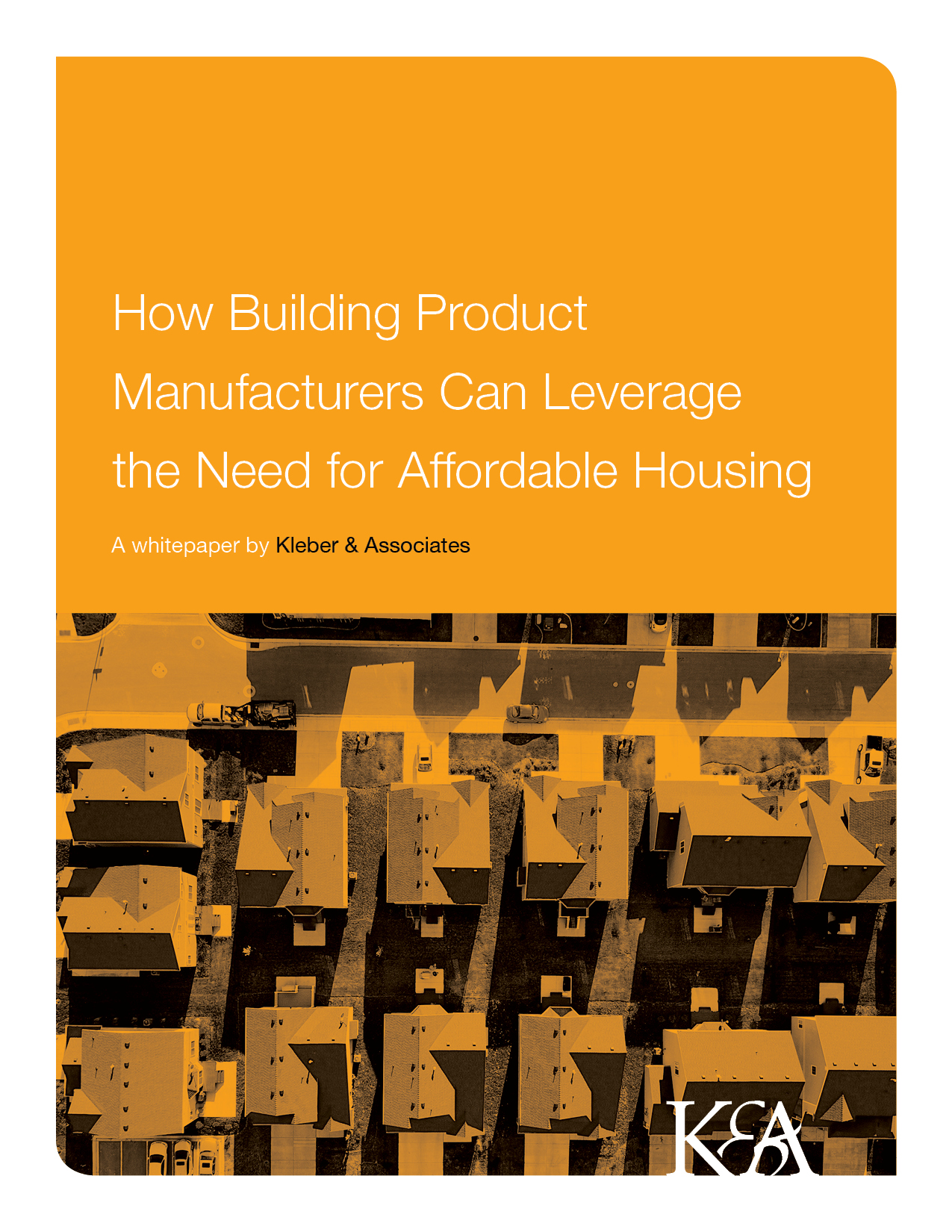How Building Product Manufacturers Can Leverage the Need for Affordable Housing
A white paper by Kleber & Associates
Walking through the downtown of any major U.S. city today amidst an infrastructure boom can be deceiving as America is currently in the middle of an affordability crisis. According to the Urban Institute, where there are 100 extremely low-income households in need of an affordable home, only 29 units are available. Roughly 39 million households are cost-burdened (i.e. more than 30 percent of income goes into housing), according to research.
Heartbreaking stories of families forcibly evicted from their home and seniors forced to choose between rent and prescription drugs are easy to spot in today’s headlines. One would expect these kinds of stories in the wake of a recession but not amid America’s best decade of economic expansion.
Much about today’s affordability crisis simply doesn’t add up. While America is experiencing an infrastructure boom, the fact remains many people – who want to buy homes – cannot, due to budget constraints. Short of government subsidies or major policy changes to address wages and inflation, it falls upon industry to create affordable housing stock that can accommodate today’s working families. With American families getting smaller (and building technology improving) there are many new avenues for manufacturers to consider in creating housing options that are affordable. And profitable.
This paper will discuss some of the data behind the home affordability crisis, including year-to-year demographics, income and economic factors, rising construction costs as well as other contributing factors. We’ll explore promising solutions, such as shared household models, public-private partnerships and innovative finance programs for first-time homebuyers.
In addition, we will look at ways building product manufacturers are innovating and partnering with local and state governments in order to get more people into affordable housing.
We Are in the Midst of an Affordable Housing Shortage
America’s Housing Affordability Crisis Only Getting Worse: Even as the economy continues to grow and the housing market rebounds from the Great Recession, many Americans are still facing growing income inequality and the inability to comfortably afford housing. This is a result of inflated housing costs and stagnant wage growth. Rents have dramatically outpaced wages which have ultimately led to more cost-burdened households. According to a recent national report, cities like Miami and San Francisco witnessed a nearly 3 percent increase in rent in 2019 versus 2018. Cities like Los Angeles and Boston saw rents rise by 5.2 percent and 7.9 percent, respectively. Some cities even saw double-digit increases in rent, including Washington, D.C. (up by 10.3 percent) and San Diego (up by 12.7 percent). The report clearly shows that a nation which prides itself on being a place of opportunity is failing to provide affordable housing solutions, leaving both renters and buyers in dismay and bewilderment.
Middle-Class Housing Crisis: In 1950, the median home price was 2.2 times the average yearly income. Then, in 2013, after the worst housing market crash in American history, median home prices expanded to 3.7 times the average income. Between 1949 and 2018, mortgage debt as part of GDP percentage has grown from 15 to 80 percent. Between 1960 and 2014, average rent as a percentage of total income in America increased by 64 percent. In contrast to this figure, household incomes grew only by 18 percent. Affordability is not the only stressor; inadequate space, homeownership and commute times are other dimensions of middle-class housing stress. Housing can create direct financial stress, as it often is the largest single household expenditure and may crowd out other necessities like food, healthcare and transportation. Metro areas like San Francisco and Seattle face several challenges for the middle class as the promise of sustainable homeownership is not a reality across the income spectrum.
Other factors exacerbating the housing crisis for the middle class are:
- Larger accommodations are often scarce in city centers.
- Crowding is a big problem as most housing units are too small to accommodate average families. Families in Texas and California are the most crowded, according to a recent report.
- Homeownership also varies with race and geography. Black and Asian people are less likely to own a house in the U.S. as compared to white people.
50-Year Affordable Housing Crisis: Only 37 affordable rental homes are available for every 100 low-income renter family (among 50 metropolitan areas). In the past 30 years, federal policies and government investments have created some affordable housing units, but they fall far from meeting the affordable housing needs of most major cities. Moreover, government investments and federal policies have in the past prioritized homeownership over affordable rental housing.
U.S. Cities with crisis-level housing shortages: According to a recent housing study covering 40 major U.S. metropolitan areas, the following cities are at the tipping point of a housing crisis:
| City Name | Number Of Homes Underwater | Percentage of Homes With Mortgage In Negative Equity | Median home value |
| New Orleans | 5,418 | 13% | $181,800 |
| Cleveland, Ohio | 13,656 | 30% | $55,900 |
| Memphis, Tenn. | 14,195 | 17% | $ 85,800 |
| Columbus, Ohio | 8,908 | 26% | $170,800 |
| Baltimore | 25,313 | 30% | $119,200 |
| Detroit | 4,964 | 38% | $161,300 |
| Chicago | 69,390 | 22% | $228,900 |
| Birmingham, Ala | 8,411 | 30% | $145,400 |
| Toledo, Ohio | 12,285 | 26% | $69,700 |
| Newark, N.J | 4,978 | 32% | $252,000 |
The word “underwater” is used for the homes that have lost all equity, meaning the total cost of the mortgage exceeds the worth of the property.
San Jose, San Francisco, Las Vegas, Los Angles, and Seattle, are the worst hit: A full-time worker on an average in the U.S. must make $ 22.10 an hour to afford a two-bedroom apartment, and $17. 90 an hour to afford a one-bedroom apartment, according to the National Low Income Housing Coalition. Especially in the Los Angeles and San Francisco Bay Area, the average home at present costs more than 10 times the income of an average citizen. Furthermore, home prices in New York, Seattle, Washington, Denver, Portland and Miami are more than five times the average income. This aggressive spike in prices has made it difficult for millennials and gen X-ers to become homeowners. These cities are also experiencing homelessness at unprecedented levels.
People Moving Less – More people are working from home now than ever and modern telework options often mean that families don’t have to pick up and head to a new city in order to take a dream job. Millennials often prefer renting than owning, as it gives them more mobility and financial freedom. What’s more, retiring Baby Boomers are more often choosing to age in their own home rather than downsizing, which impacts the supply of new inventory. According to the National Association of Realtors, the inventory of salable homes is currently a 3.5 month supply, which indicates that in real-time, this is a seller’s market.
Labor shortages and rising construction costs – A bigger threat to this labor-driven industry is the growing shortage of workers. After the 2008 recession, 600,000 workers left the business, never to return and today, craftsmen often avoid construction, perceiving it as dangerous and difficult. According to the U.S. Labor Bureau Statistics, around 434,000 construction jobs are vacant as of April 2019. Furthermore, as of 2026, the vacancies in the construction industry are set to reach an astonishing 747,000, according to the bureau. This existential threat is connected to the 5.86 percent increase in construction costs, as reported in 2018 from the previous year. Construction costs are expected to increase anywhere from 0 to 9 percent every year while long-term permanent loan rates are expected to remain flat. In a report by Housing Finance, the average construction cost per square foot for a studio apartment is around $116.38 but the median amount is originally estimated at $100.50. Richard Lara, president and CEO of RAAM Construction says: “Both material and skilled labor costs in construction have been on the rise for some time, and today’s multifamily developers are seeking cost-effective ways to bring multi-unit projects to fruition,” according to Globest.
This fundamental demand-supply imbalance naturally affects rent and construction costs. The more costly it is to build, the higher rents must be in order for builders and developers to turn a profit. As a result, new construction projects for the higher end of the market are prioritized, while new development at the lower and middle ends of the income spectrum is limited.
How the industry is responding to the affordable housing shortage
The affordable housing crisis has made nearly 21 million Americans rent-burdened and made the risk of homelessness considerably high. Many building product manufacturers are working with local governments, exploring new supply chains and thinking outside of the box to produce homes and apartments for less and in places where homes are in high demand. Here are some examples of things taking place in the building products marketplace.
Vertical Integration and Modular Construction to Cut Costs – Companies like Katerra are setting up a new class of innovation in Silicon Valley, as they are applying tested system approaches adopted from other industries into design and construction. With lots of venture capital secured, Katerra hopes to create a vertically integrated, end-to-end service that will pave a way for modular building. The potential benefits of modular building include reduced construction times and potentially significant cost savings. Although there are some critiques of modular construction who dismiss it as producing low-quality, ‘cookie-cutter’ homes, companies are starting to explore modular construction as a way to integrate design, technology, material sourcing, logistics, manufacturing and construction into a single integrated system.
Modular construction is different from general off-site construction. The first of these kind of buildings were used during World War I, also known as military “mobilization buildings.” The construction is done in a climate-controlled, factory-like environment and employs assembly line technology in order to construct building components and transport them directly to a construction site. These components vary from precast concrete to SIPs (structural insulated panels). Structural items such as truss assemblies and wall panels and nonstructural items like lighting and cabinetry are all assembled offsite, reducing material staging needs and installation times while lowering overhead costs. In the past, these modules have been used mainly as detached housing units, where they are pieced together upon a permanent chassis and then transported to finished building sites. However, this technology can be easily applied to larger buildings, apartment complexes, townhouses and high-rise offices.
3-D printed homes – 3D printing is used for several different things starting from prototype design to traditional manufacturing and even construction. Using commercial grade printers, entire buildings can fabricated in record time. Small homes can be ‘printed’ in the course of a day. The technology uses concrete and wood as raw materials which specifically turns out to be a low-cost solution. With raw materials in hand, the technology is relatively fast and is a budget-friendly way to develop structures, which can be a game changer in low-income areas and third-world environments. Companies like ICON have created printers, advanced materials and robotics that are revolutionizing homebuilding. ICON’s advanced techniques are capable of 3D printing entire communities with up to at least 2,000 square foot homes.
Self-deploying modular homes- Companies like Ten Fold Engineering are exploring the concept of self-deploying modular homes. The company is developing homes that can be transported on single flatbed truck that that with a push of a button in eight minutes without having to set a foundation, hire builders, or employ heavy machinery. This concept can reduce the transportation cost of building a home to one trip and greatly reduce overhead costs. The system is reversible, as all major fixtures and internal structures are pre-installed, making these homes instantly habitable. The folding portions are customizable (turn it into an office or a home) and all partitions are interchangeable. To support homes in less-developed areas, off-grid power systems and or pods for batteries can be installed.
PropTech – A few years ago, no one was talking about PropTech. While it’s mostly considered a buzzword to classify startups offering innovative products or new business models for the real estate markets, PropTech startups are gearing up to disrupt the industry. A few of them, such as Zillow, have been working on for a while. An example of this is Zillow’s use of Sun Number, which uses satellite technology to locate homes conducive to cheap, affordable solar energy. Other PropTech companies are focused on energy and materials to make homes less expensive, such as AeroShield, which makes an advanced glass for highly-insulating windows and EnKoat, which is applying tech to paints and plasters to drastic reduce HVAC and heating costs. As PropTech emerges, it is finding alignment with smart cities and buildings, the sharing economy, the home building industry (ConTech) and finance (FinTech). PropTech companies are opening new avenues to cut housing costs through energy use and material choices.
Community Examples – Since affordable housing crisis have reached middle class of the United States, the idea of downsizing lifestyle has become a trend. This trend started off with tiny houses which has now become more of a social movement. People simplify their living, and live with less, which in return earns them financial freedom, peace and time. One of the oldest tiny home villages is in Seattle, and now the tiny wave is crossing oceans.
Another solution for the housing affordability crisis are shared housing models like the ‘home stay’ program developed by New York University, where college students in need of housing live in a spare bedroom of local senior citizens. This program helps students and seniors by providing seniors with companionship and enabling them to have more independence, while saving students an average of $7,000 they would need to afford a semester of rent in a New York City dorm or apartment.
Still, the affordable housing crisis is far from not-being a threat, as a long term solution has to be devised where venture capital firms, public players, and startups can decidedly join hands and aim towards determining quick affordable housing solutions. Investments can be made in proposed and permanent affordability resolves like 3D printed homes, or self-modular homes.












